Click to see the abstract
Notes from the talk at Oberwalfach
As observed by Kawamata, a Q-Gorenstein smoothing of a Wahl singularity gives rise to a one-parameter flat degeneration of a matrix algebra. A similar result holds for a general smoothing of any two-dimensional cyclic quotient singularity, where the matrix algebra is replaced by a hereditary algebra. From a categorical perspective, these one-parameter families of finite-dimensional algebras "absorb" the singularities of the threefold total spaces of smoothings. These results were established using abstract methods of birational geometry, making the explicit computation of the family of algebras challenging. Using mirror symmetry for genus-one fibrations, we identify a remarkable immersed Lagrangian with a bounding cochain in the punctured torus. The endomorphism algebra of this Lagrangian in the relative Fukaya category corresponds to this flat family of algebras. This enables us to compute Kawamata's matrix order explicitly.

Click to see the abstract
Nelder Fellow lectures and animations of the quantum spectrum in two-ray games
We study the derived category of the moduli space \( \mathcal{SU}_C(2) \) of rank 2 vector bundles on a smooth projective curve \( C \) of genus \( g \geq 2 \) with trivial determinant. This generalizes the recent work by Tevelev and Torres on the case with fixed odd determinant. Since \( \mathcal{SU}_C(2) \) is singular, we work with its noncommutative resolution of singularities constructed by Padurariu and Spenko--Van den Bergh (in the more general setting of symmetric stacks). We show that this noncommutative resolution admits a semiorthogonal decomposition into derived categories of symmetric powers \( \operatorname{Sym}^{2k}C \) for \( 2k \leq g - 1 \). In the case of even genus, each block appears four times. This is also true in the case of odd genus, except that the top symmetric power \( \operatorname{Sym}^{g-1}C \) appears twice. In the case of even genus, the noncommutative resolution is strongly crepant in the sense of Kuznetsov and categorifies the intersection cohomology of \( \mathcal{SU}_C(2) \). Since all of its components are "geometric," our semiorthogonal decomposition provides evidence for the expectation, which dates back to the work of Newstead and Tyurin, that \( \mathcal{SU}_C(2) \) is a rational variety. Finally, we study mutations of semiorthogonal decompositions on the Hecke correspondence, answering a question of Padurariu and Toda.

Click to see the abstract
Nelder Fellow lectures and animations of the quantum spectrum in two-ray games
Let N be the moduli space of stable rank 2 vector bundles on a smooth projective curve of genus g>1 with fixed odd determinant. With Sebastian Torres, we previously found a semi-orthogonal decomposition of the bounded derived category of N into bounded derived categories of symmetric powers of the curve and, possibly, a phantom block. In this work, we employ the theory of weaving patterns to eliminate the possibility of a phantom, completing the proof of the decomposition conjectured by Narasimhan and, independently, by Belmans, Galkin, and Mukhopadhyay.

Click to see the abstract
Lecture notes (Algebra Seminar at UCLA)
It is well known that a 2-dimensional cyclic quotient singularity W has the same singularity category as a finite dimensional associative algebra R introduced by Kalck and Karmazyn. We study the deformations of the algebra R induced by the deformations of the surface W to a smooth surface. We show that they are Morita--equivalent to path algebras R̂ of acyclic quivers for general smoothings within each irreducible component of the versal deformation space of W (as described by Kollár and Shepherd-Barron). Furthermore, R̂ is semi-simple if and only if the smoothing is Q-Gorenstein (one direction is due to Kawamata). We provide many applications. For example, we describe strong exceptional collections of length 10 on all Dolgachev surfaces and classify admissible embeddings of derived categories of quivers into derived categories of rational surfaces.
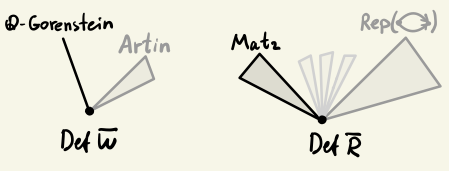
Click to see the abstract
Nelder Fellow lectures and animations of the quantum spectrum in two-ray games
Let C be a smooth projective curve of genus g>1 and let N be the moduli space of stable rank 2 vector bundles on C of odd degree. We construct a semi-orthogonal decomposition of the bounded derived category of N conjectured by Narasimhan and by Belmans, Galkin and Mukhopadhyay. It has two blocks for each i-th symmetric power of C for i=0,...,g-2 and one block for the (g-1)-st symmetric power. We conjecture that the subcategory generated by our blocks has a trivial semi-orthogonal complement, proving the full BGMN conjecture. Our proof is based on an analysis of wall-crossing between moduli spaces of stable pairs, combining classical vector bundles techniques with the method of windows.

Click to see the abstract
Slides and video of the talk at the Seminario de Geometria Algebraica (2020)
We construct projective toric surfaces whose blow-up at a general point has a non-polyhedral pseudo-effective cone. As a consequence, we prove that the pseudo-effective cone of the Grothendieck--Knudsen moduli space M0,n of stable rational curves is not polyhedral for n≥10. These results hold both in characteristic 0 and in characteristic p, for all primes p. Many of these toric surfaces are related to an interesting class of arithmetic threefolds that we call arithmetic elliptic pairs of infinite order. Their analysis relies on tools of arithmetic geometry and Galois representations in the spirit of the Lang--Trotter conjecture, producing toric surfaces whose blow-up at a general point has a non-polyhedral pseudo-effective cone in characteristic 0 and in characteristic p, for an infinite set of primes p of positive density.
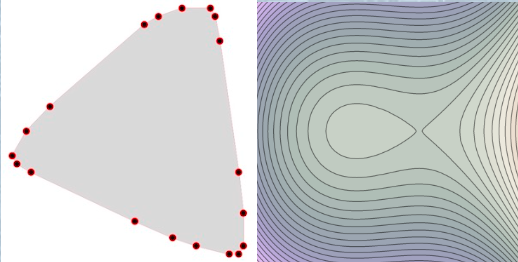
Click to see the abstract
Lecture notes (Geometry Seminar at UT Austin)
Equations of hypertree divisors on the Grothendieck-Knudsen moduli space of stable rational curves, introduced by Castravet and Tevelev, appear as numerators of scattering amplitude forms for n massless particles in N=4 Yang-Mills theory in the work of Arkani-Hamed, Bourjaily, Cachazo, Postnikov and Trnka. Rather than being a coincidence, this is just the tip of the iceberg of an exciting relation between algebraic geometry and high energy physics. We interpret scattering amplitude forms as probabilistic Brill-Noether theory: the study of statistics of images of n marked points under a random meromorphic function uniformly distributed with respect to the translation-invariant volume form of the Jacobian. We focus on the maximum helicity violating regime, which leads to a beautiful physics-inspired geometry for various classes of algebraic curves: smooth, stable, hyperelliptic, real algebraic, etc.

Click to see the abstract
We prove the Manin-Orlov conjecture: the moduli space of stable rational curves with n marked points has a full exceptional collection equivariant under the action of the symmetric group Sn permuting the marked points. In particular, its K-group with integer coefficients is a permutation Sn-lattice.

Click to see the abstract
Lecture video and Lecture notes (Tropical Geometry in Zoom Seminar)
Projective duality identifies moduli spaces of points in P2 and lines in the dual P2. The latter space admits Kapranov's Chow quotient compactification, studied also by Lafforgue, Hacking, Keel, Tevelev, and Alexeev, which gives an example of a KSBA moduli space of stable surfaces: it carries a family of reducible degenerations of P2 with "broken lines". Gerritzen and Piwek proposed a dual perspective, a compact moduli space parametrizing reducible degenerations of P2 with n smooth points. We investigate the relation between these approaches, answering a question of Kapranov from 2003.
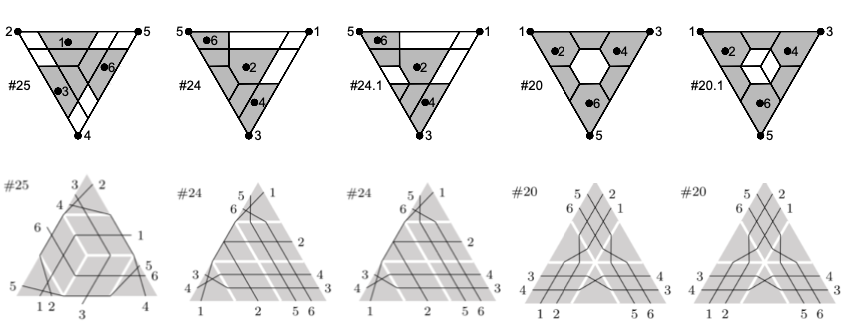
Click to see the abstract
Abstract. We extend tropicalization and tropical compactification of subvarieties of algebraic tori to subvarieties of spherical homogeneous spaces. Given a tropical compactification of a subvariety, we show that the support of the colored fan of the ambient spherical variety agrees with the tropicalization of the subvariety. The proof is based on our equivariant version of the attening by blow-up theorem. We provide many examples.

Click to see the abstract
We construct an S2xSn invariant full exceptional collection on Hassett spaces of weighted stable rational curves with n+2 markings and weights (1/2+a,1/2+a,b,...,b), for very small positive a,b, that can be identified with symmetric GIT quotients of (P1)n by the diagonal action of Gm when n is odd, and their Kirwan desingularization when n is even. The existence of such an exceptional collection is one of the needed ingredients in order to prove the existence of a full Sn-invariant exceptional collection on the moduli space of stable rational curves with n marked points . To prove exceptionality we use the method of windows in derived categories. To prove fullness we use previous work on the existence of invariant full exceptional collections on Losev-Manin spaces.
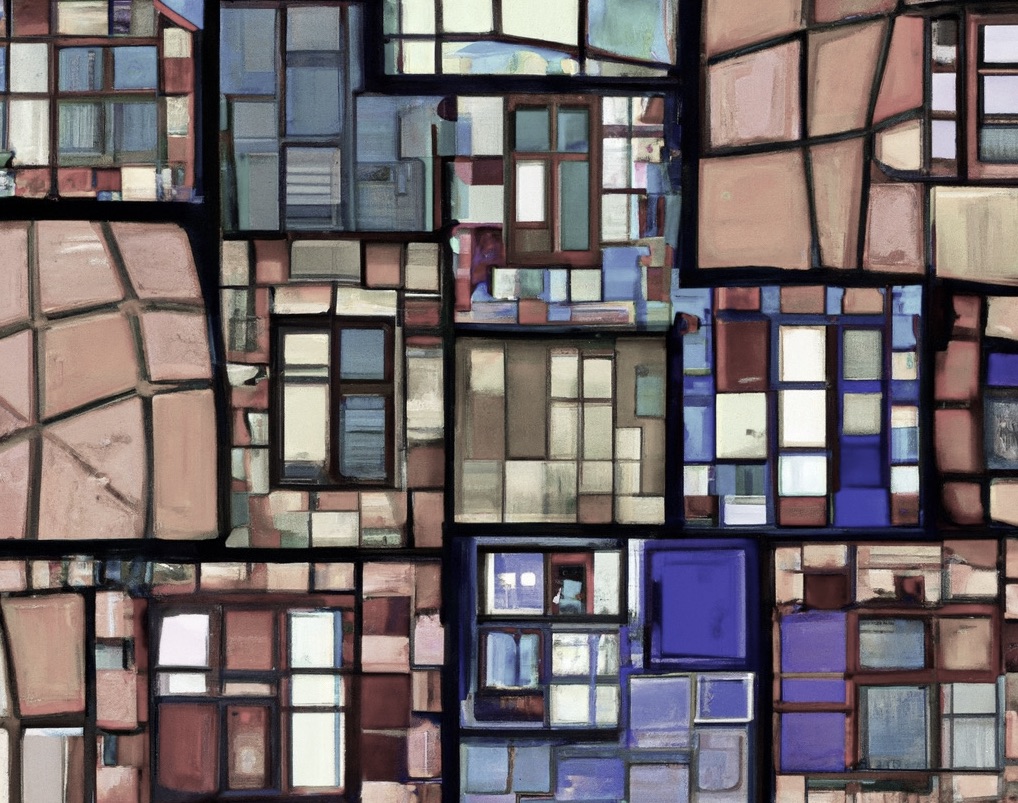
Click to see the abstract
This is the first paper in the sequence devoted to derived category of moduli spaces of curves of genus 0 with marked points. We develop several approaches to describe it equivariantly with respect to the action of the symmetric group permuting marked points. We construct an equivariant full exceptional collection on the Losev-Manin space which categorifies derangements.
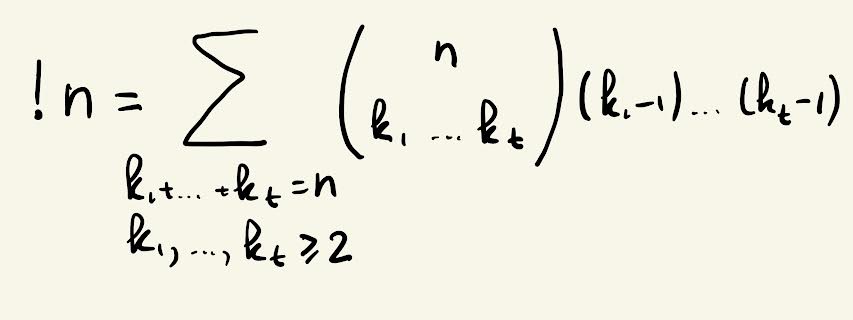
Click to see the abstract
We show that the Craighero-Gattazzo surface, the minimal resolution of an explicit complex quintic surface with four elliptic singularities, is simply-connected. This was conjectured by Dolgachev and Werner, who proved that its fundamental group has a trivial profinite completion. The Craighero-Gattazzo surface is the only explicit example of a smooth simply-connected complex surface of geometric genus zero with ample canonical class. We hope that our method will find other applications: to prove a topological fact about a complex surface we use an algebraic reduction mod p technique and deformation theory.

Click to see the abstract
We study semistable extremal threefold neighborhoods following earlier work of Mori, Kollár, and Prokhorov. We classify possible flips and extend Mori's algorithm for computing flips of extremal neighborhoods of type k2A to more general neighborhoods of type k1A. In fact we show that they belong to the same deformation family as k2A, and we explicitly construct the universal family of extremal neighborhoods. This construction follows very closely Mori's division algorithm, which we interpret as a sequence of mutations in the cluster algebra of rank 2 with general coefficients. We identify, in the versal deformation space of a cyclic quotient singularity, the locus of deformations such that the total space admits a (terminal) antiflip. We show that these deformations come from at most two irreducible components of the versal deformation space. As an application, we give an algorithm for computing stable one-parameter degenerations of smooth projective surfaces (under some conditions) and describe several components of the Kollár-Shepherd-Barron boundary of the moduli space of smooth canonically polarized surfaces of geometric genus zero.
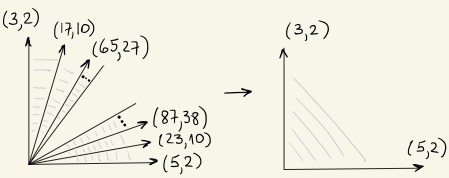
Click to see the abstract
Building on the work of Goto, Nishida and Watanabe on symbolic Rees algebras of monomial primes, we prove that the moduli space of stable rational curves with n punctures is not a Mori Dream Space for n>133. This answers the question of Hu and Keel.

Click to see the abstract
We answer positively a question of B. Teissier on existence of resolution of singularities inside an equivariant map of toric varieties.
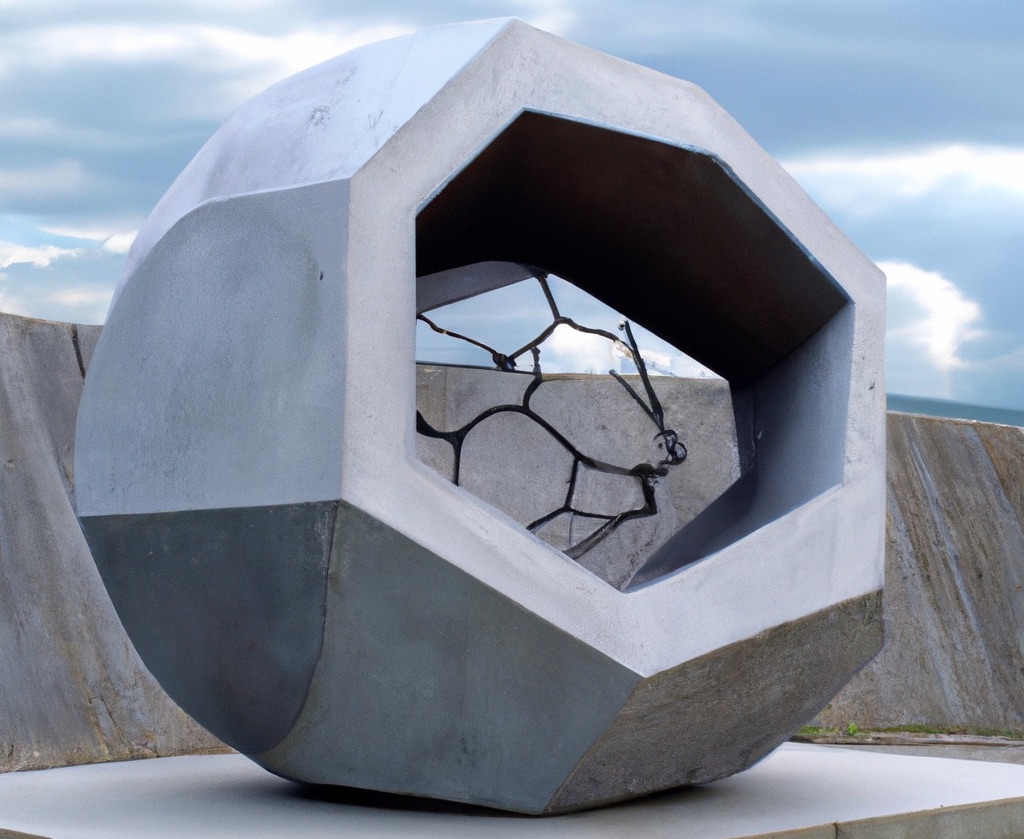
Click to see the abstract
A database of hypertree divisors by Scheidwasser and Opie.
We give a description for the subcone of effective divisors of the Grothendieck-Knudsen moduli space of stable rational curves with n marked points. Namely, we introduce new combinatorial structures called hypertrees and show they give exceptional divisors with many remarkable properties.
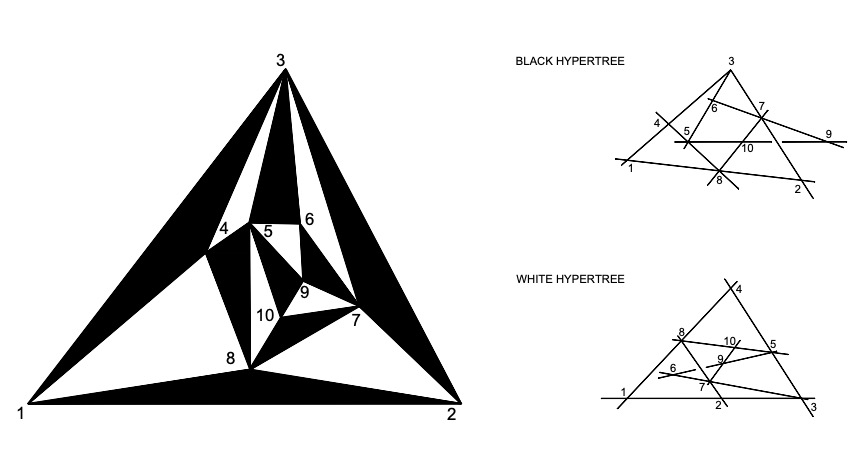
Click to see the abstract
A result of Keel and McKernan states that a hypothetical counterexample to the F-conjecture must come from rigid curves on the moduli space of stable rational curves that intersect the interior. We exhibit several ways of constructing rigid curves. In all our examples, a reduction mod p argument shows that the classes of the rigid curves that we construct can be decomposed as sums of F-curves.
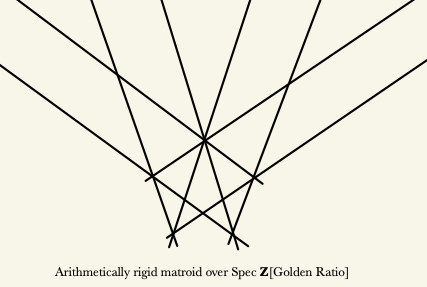
Click to see the abstract
We give a functorial normal crossing compactification of the moduli of smooth marked cubic surfaces entirely analogous to the Grothendieck-Knudsen moduli space of stable rationale curves.

Click to see the abstract
We show that the log canonical bundleof the moduli space of stable rational curves is very ample, show the homogeneous coordinate ring is Koszul, and give a nice set of rank 4 quadratic generators for the homogeneous ideal: The embedding is equivariant for the symmetric group, and the image lies on many Segre embedded copies of P1xP2x...xPn-3, permuted by the symmetric group. The homogeneous ideal of the moduli space is the sum of the homogeneous ideals of these Segre embeddings.

This preprint was superseded by [21] and [22]. It is not intended for publication.
Click to see the abstract
Tropical algebraic geometry offers new tools for elimination theory and implicitization. We determine the tropicalization of the image of a subvariety of an algebraic torus under any homomorphism from that torus to another torus.

Click to see the abstract
We apply tropical geometry to study the image of a map defined by Laurent polynomials with generic coefficients. If this image is a hypersurface then our approach gives a construction of its Newton polytope.
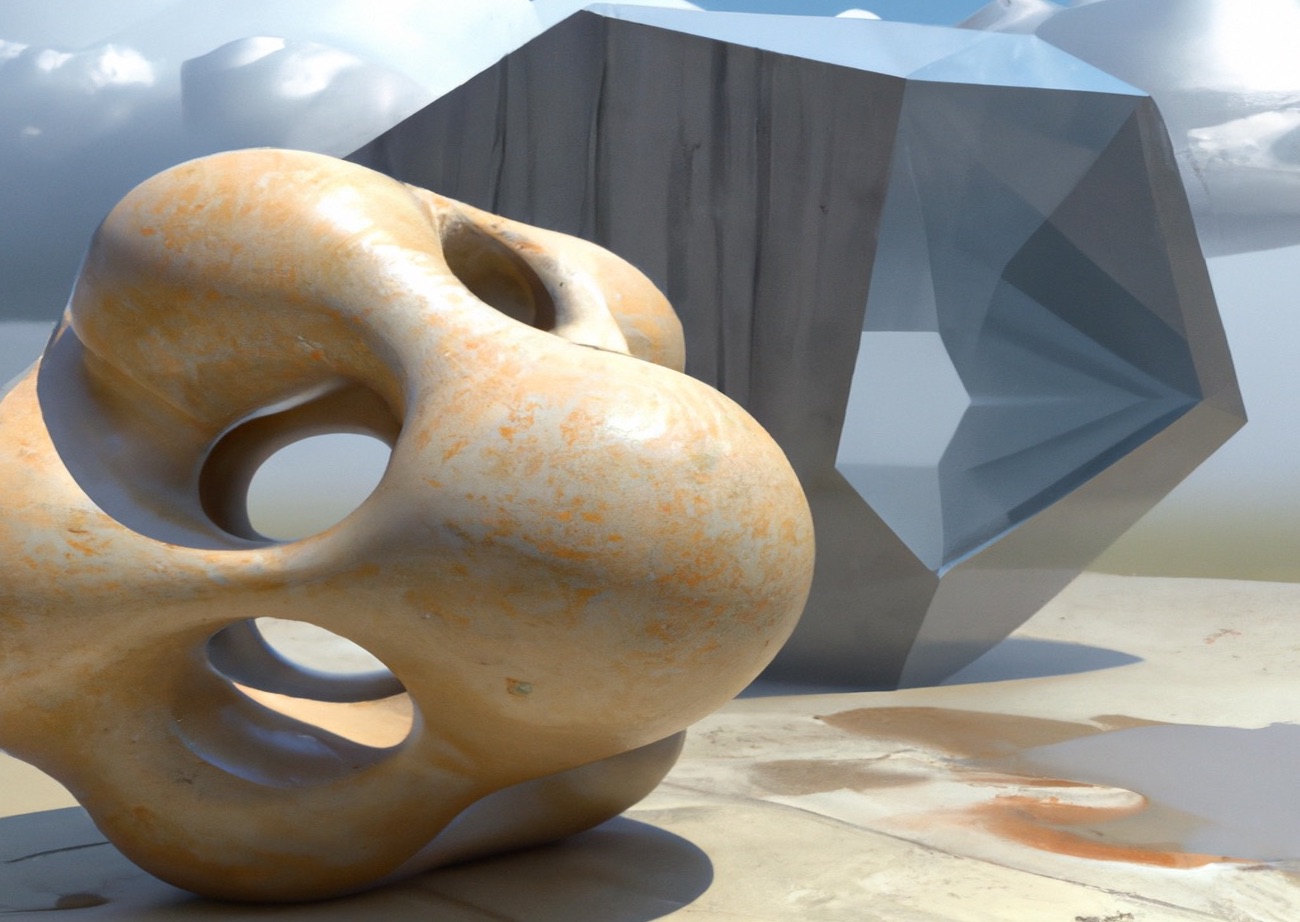
Click to see the abstract
We study compactifications of subvarieties of algebraic tori defined by imposing a sufficiently fine polyhedral structure on their non-archimedean amoebas. These compactifications have many nice properties, for example any k boundary divisors intersect in codimension k. We consider some examples including the moduli space of stable rational curves (and more generally log canonical models of complements of hyperplane arrangements) and compact quotients of Grassmannians by a maximal torus.
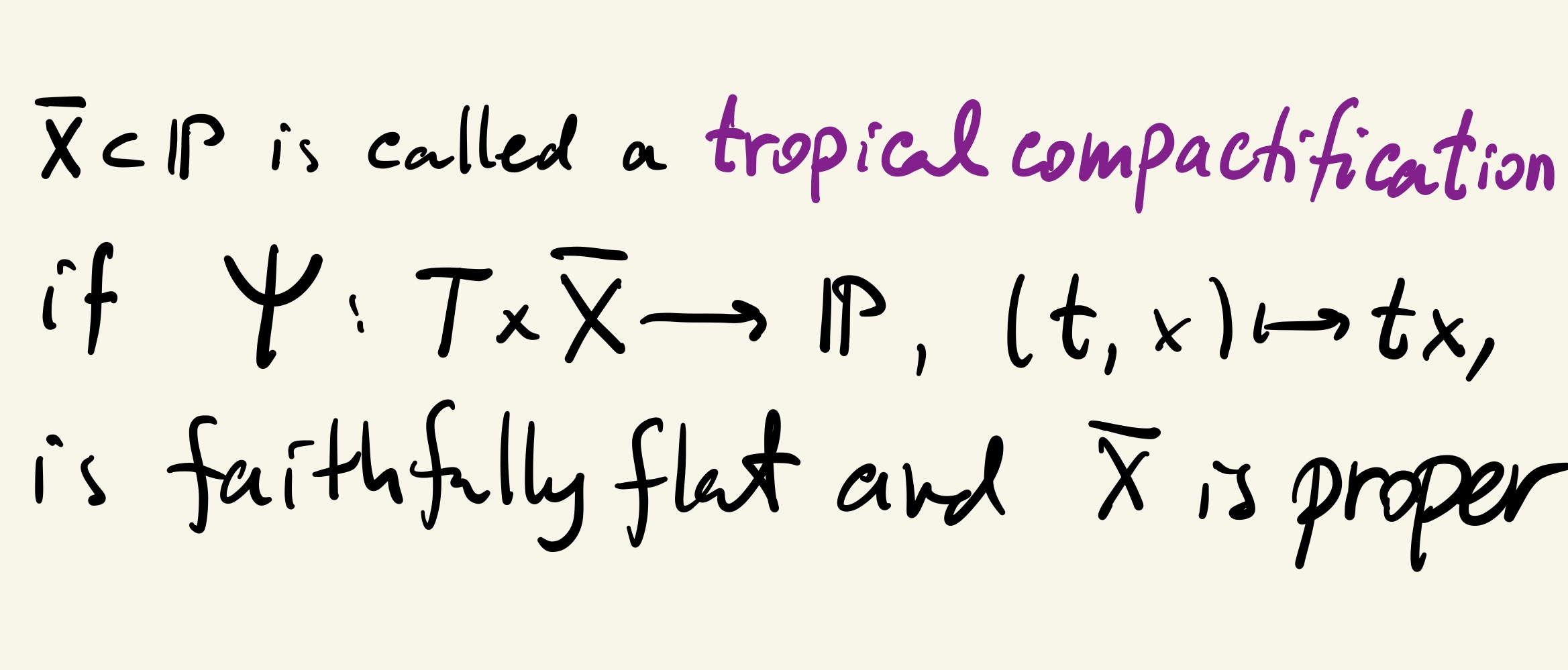
Click to see the abstract
Consider the moduli space M0 of arrangements of n hyperplanes in general position in projective (r-1)-space. When r=2 the space has a compactification given by the moduli space of stable curves of genus 0 with n marked points. In higher dimensions, the analogue of the moduli space of stable curves is the moduli space of stable pairs: pairs (S,B) consisting of a variety S (possibly reducible) and a divisor B=B1+...+Bn satisfying various additional assumptions. We identify the closure of M0 in the moduli space of stable pairs as Kapranov's Chow quotient compactification of M0, and give an explicit description of the pairs at the boundary. We also construct additional irreducible components of the moduli space of stable pairs.

Click to see the abstract
Our main result is the description of generators of the total coordinate ring of the blow-up of Pn in any number of points that lie on a rational normal curve. As a corollary we show that the algebra of invariants of the action of a two-dimensional vector group introduced by Nagata is finitely generated by certain explicit determinants. We also prove the finite generation of the algebras of invariants of actions of vector groups related to T-shaped Dynkin diagrams introduced by Mukai.
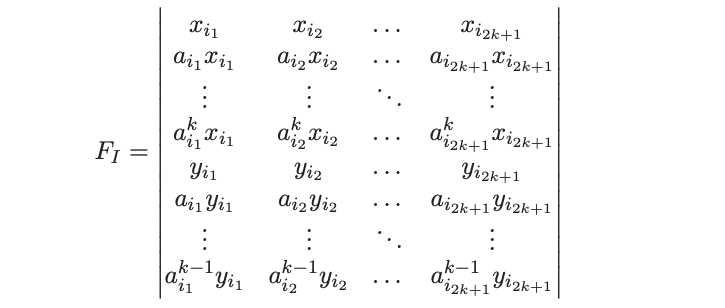
Click to see the abstract
We consider Kapranov's Chow quotient compactification of the moduli space of ordered n-tuples of hyperplanes in Pr-1 in linear general position. For r=2 this is canonically identified with the Grothendieck-Knudsen moduli space of stable rational curves which has among others the nice properties 1) Modular meaning: stable pointed rational curves 2) Canonical description of limits of one parameter degenerations 3) Natural Mori theoretic meaning: log canonical compactification. We prove (1-2) generalize naturally to all (r,n), but that (3), which we view as the deepest, fails except possibly in the cases (2,n),(3,6),(3,7),(3,8), where we conjecture it holds.
Update. The conjecture was proved by Luxton-Qu (3,6), Corey (3,7), Corey-Luber (3,8).
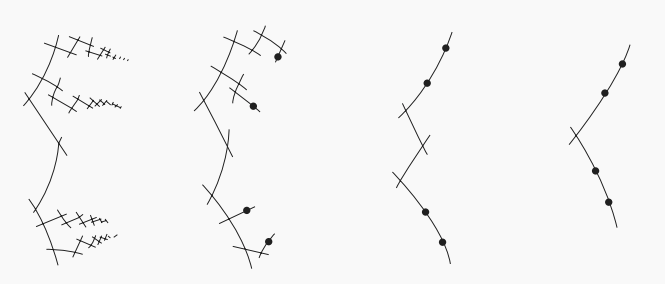
Click to see the abstract
For several centuries, various reincarnations of projective duality have inspired research in algebraic and differential geometry, classical mechanics, invariant theory, combinatorics, etc. On the other hand, projective duality is simply a systematic way of recoveringthe projective variety from the set of its tangent hyperplanes. In this survey we have tried to collect together different aspects of projective duality and points of view on it. We hope, that the exposition is quite informal and requires only a standard knowledge of algebraic geometry and algebraic (or Lie) group theory. Some chapters are, however, more difficult and use the modern intersection theory and homology algebra. But even in these cases we have tried to give simple examples and avoid technical difficulties.
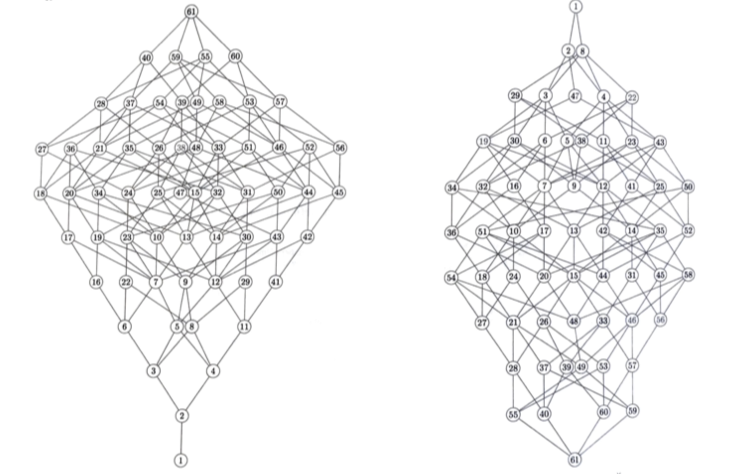
Click to see the abstract
We define and study several equivariant stratifications of the isotropy and coisotropy representations of a parabolic subgroup in a complex reductive group.
Click to see the abstract
We discover a class of projective self-dual algebraic varieties. Namely, we consider actions of isotropy groups of complex symmetric spaces on the projectivized nilpotent varieties of isotropy modules. For them, we classify all orbit closures X such that X is isomorphic to its projective dual. We give algebraic criteria of projective self-duality for the considered orbit closures.
Click to see the abstract
A Moore--Penrose inverse of an arbitrary complex matrix A is defined as a unique matrix A' such that AA'A=A, A'AA'=A', and AA', A'A are Hermitian matrices. We show that this definition has a natural generalization in the context of shortly graded simple Lie algebras corresponding to parabolic subgroups with aura (abelian unipotent radical) in simple complex Lie groups, or equivalently in the context of simple complex Jordan pairs. We give further generalizations and applications.
Click to see the abstract
We compute dimensions of maximal isotropic subspaces of generic symmetric and skew-symmetric forms of any degree.
Click to see the abstract
We find all homogeneous symplectic varieties of connected reductive algebraic groups that admit an invariant linear connection.
Click to see the abstract
Let g be the Lie algebra of a complex semisimple Lie group G. Let s be an involution of G and let K=Gs be the subgroup of fixed points. Consider the direct sum decomposition g=k+p into the eigenspaces for s. Denote by a any maximal abelian ad-diagonalizable subalgebra of p and by W=NK(a)/ZK(a) the baby Weyl group. By the Chevalley restriction theorem for isotropy subspaces of symmetric spaces, the restriction map of algebras of invariants C[p]K->C[a]W is an isomorphism. The aim of this paper is prove that the restriction map C[pxp]K->C[axa]W is surjective, generalizing the analogous result of Joseph for the adjoint action of the reductive group.
Click to see the abstract
Click to see the abstract
The paper deals with the configuration of subalgebras in generic n-dimensional k-argument anticommutative algebras and ``regular'' anticommutative algebras.
Click to see the abstract
We study generic commutative and anticommutative algebras of fixed dimension, their invariants, covariants and algebraic properties (e.g., the structure of subalgebras). In the case of 4-dimensional anticommutative algebras, we relate the structure of subalgebras to the configuration of 27 lines on the associated cubic surface. We prove rationality of the corresponding moduli space. In the case of 3-dimensional commutative algebras, a new proof of a recent theorem of Katsylo and Mikhailov about the 28 bitangents to the associated plane quartic is given.
Click to see the abstract
A linear action of a reductive group is called unstable if its generic orbits are not closed or, equivalently, if stabilizers of generic points are not reductive. The Lie algebra of a Levi subalgebra of a generic stabilizer is called the Cartan subalgebra and we compute them for all unstable linear actions of connected simple groups and for all unstable irreducible linear actions of connected semisimple groups.